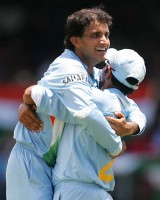Shape up or ship out
Unfit and overweight, India's one-day cricketers are being muscled off the park
26-Mar-2007
|
|

|
The cloud currently hovering over Indian cricket has a silver lining: It offers a chance to scrap the game as it exists in India today and start afresh. Change the way domestic cricket is treated, change the star system of the international team, change the way the international calendar is packed beyond reason. Change the way the Board of Control for Cricket in India runs the game, its vision both myopic and blinkered.
None of that is going to happen, of course; the men who run Indian cricket have far more important things to do than to look at ways of improving the game. Yet there is one area where change, if not carried out, will actually impact their bottom line, and that concerns the fitness of India's one-day team. One-day cricket has evolved into a power game and India are in danger of being muscled off the park. Just as it happened in hockey 30 years ago.
The most striking example of power cricket was, of course, the game between Australia and South Africa at Basseterre on Saturday, which was light years ahead of what India had offered the previous day. The batting was brutal and, in Australia's case, a theme right down the order; the fielding was electric, South Africa saving 40-50 runs through their sheer class of ground fielding. The power cricket ran through both teams, as indeed it does through New Zealand as well. One could not picture India's batsmen or fielders reaching anywhere close to those standards. Our best fielder, Yuvraj Singh, is a sloth by comparison.
Unfortunately, that is the future of one-day cricket and is also the motif of the latest entrant, Twenty20. Test cricket will still place a premium on its traditional qualities of timing and placement, but fitness, athleticism and physical strength will be the determinants ruling the shorter - and, lest we miss the point, more lucrative - versions. If India are to win, if the BCCI are to protect its bottomline, the players must shape up or ship out.
Just over three decades ago hockey underwent a fundamental change, moving from grass to astroturf. The new surface helped players who were fit, fast and strong; it impeded the touch play and dribbling skills that had always given India's players an edge. India's transition was slow and painful; more than six years after the change, the team was beaten 7-1 by Pakistan in the final of the 1982 Asiad at New Delhi's National Stadium, the ultimate hockey humiliation.
The year before astroturf was brought in, India won the World Cup at Kuala Lumpur; in the 32 years since, they have won just one Olympic gold, that too because of a weakened field at the Moscow Olympics. The likes of Korea, Argentina and Spain - scarcely traditional powerhouses - have overtaken India in the rankings because they have adapted to the new game far better. Its long passes and hard hitting are not exciting to watch - like power cricket, where the endless clobbering of fours and sixes can also pale after a while - but it wins matches.
Similarly, Indian tennis players were left straggling when the game traded in wooden rackets for aluminium and other material; touch artists like Ramesh Krishnan just couldn't cope with the emerging power game that undermined all their strong points. It took the arrival of Leander Paes, a generation later, to restore India to the world map. Paes was not possessed of a particularly powerful game but he had the stamina to play three or four hours and win through attrition.
|
|

|
India's current one-day team has neither the strength nor the stamina. It is packed with players long past their sell-by date - and anyone who draws a parallel with Australia is missing the basic point that Australians are naturally fitter and stronger and stay that way far longer. India are in danger of being left behind by a faster, more physical game.
Interestingly, Sri Lanka have been able to balance youth and experience, elegance and power. They are playing good one-day cricket and they know it - it shows on their faces. This, despite their problems - their cricket board is more shambolic (yes, it's possible) than India's, they have their share of prima donnas, they've had captains coming in and out of the side. They have a minuscule talent pool to choose from.Yet Mahela Jayawerdene leads a team most neutrals are hoping will go all the way in the West Indies.
With the next World Cup four years away, India, too, can do that but it would have to exercise several hard options. The one germane to this argument is to separate the Test and ODI teams and, for the latter, rip up the existing team sheet and start afresh. Build a younger side with the likes of Robin Uthappa and Dinesh Karthik, aiming purely at the tournament that will be hosted in South Asia, and drop those unlikely to play in that tournament. If that means an untested ODI captain, so be it; he has four years to master the job. So does his team.
It is a policy admittedly fraught with risks but India's bench strength, while not having a Tendulkar, Ganguly or Dravid, has players far more energetic, hungry and motivated - and who, four years later, will be less likely to lose to Bangladesh without a fight.
Jayaditya Gupta is executive editor of Cricinfo